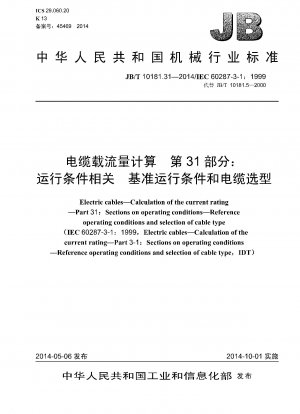JB/T 10181.31-2014
Electric cables.Calculation of the current rating.Part 31: Sections on operating conditions.Reference operating conditions and selection of cable type (English Version)
- Standard No.
- JB/T 10181.31-2014
- Language
- Chinese, Available in English version
- Release Date
- 2014
- Published By
- Professional Standard - Machinery
- Latest
- JB/T 10181.31-2014
- Replace
- JB/T 10181.5-2000
- Scope
- This part of JB/T 10181 specifies the basic operating conditions and cable selection related to the operating conditions. This section applies to the steady-state operating conditions of all AC voltage and DC voltage cables of 5 kV and below laid in the air or soil. The soil includes cables laid directly buried in the ground, pipes, cable trenches or steel pipes with or without local soil drying. The term "steady state" refers to a continuous constant current (100% load factor) that is just sufficient to asymptotically reach the maximum conductor temperature under constant ambient conditions. This section contains baseline operating conditions and cable selection.
JB/T 10181.31-2014 Referenced Document
- IEC 60183 Guidance for the selection of high-voltage A.C. cable systems*, 2015-01-01 Update
JB/T 10181.31-2014 history
- 2014 JB/T 10181.31-2014 Electric cables.Calculation of the current rating.Part 31: Sections on operating conditions.Reference operating conditions and selection of cable type
- 2000 JB/T 10181.5-2000 Calculation of the current rating of electric cables.Part 3:Sections on operating conditions.Section 1:Reference operating conditions and selection of cable type
JB/T 10181.31-2014 Electric cables.Calculation of the current rating.Part 31: Sections on operating conditions.Reference operating conditions and selection of cable type has been changed from JB/T 10181.5-2000 Calculation of the current rating of electric cables.Part 3:Sections on operating conditions.Section 1:Reference operating conditions and selection of cable type.
